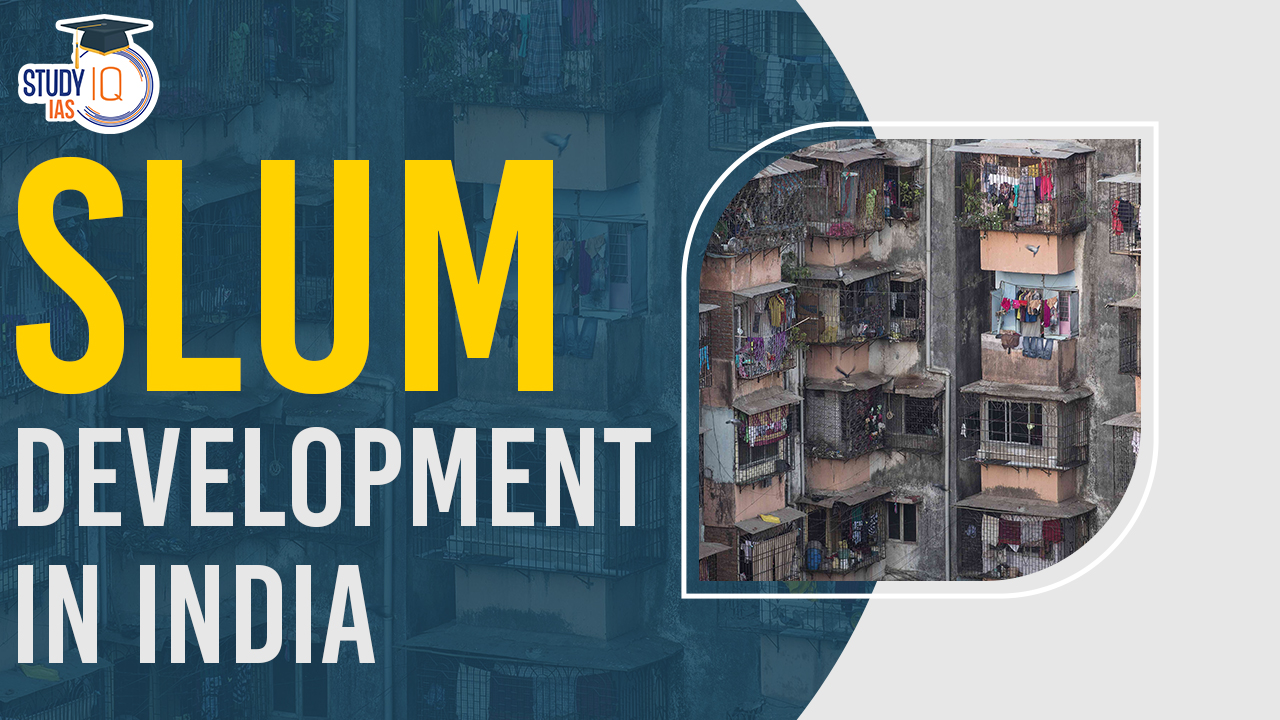Table of Contents
Context: The subject of slums has found a prominent place in the debates and discussions of the Indian Parliament, the shifting views influences how laws and policies handle slum issues.
About Slum
- Slum” typically refers to city areas with unregulated housing and poor, dense living conditions.
- These areas are usually highly populated and offer very limited space for residents.
- According to UN-HABITAT, a slum dwelling is characterised by a group of people under one roof lacking in one or more areas:
- Sturdy and weatherproof housing.
- Adequate room, with a guideline of no more than three people per room.
- Affordable and readily available clean drinking water.
- Sufficient sanitation facilities, such as a shared public or private toilet for a sensible number of users.
- Legal protection against being forcibly removed from their homes.
We’re now on WhatsApp. Click to Join
Reasons For The Development Of Slums In India
- Inadequate Urban Planning: The lack of well-structured urban planning has been a key factor in the emergence of slums.
- For instance, Indian cities like Mumbai and Delhi have grown rapidly, with urban planning not keeping pace with the influx of people, leading to haphazardly constructed settlements.
- Rapid Urbanisation: The swift migration of people to cities in search of better opportunities has contributed to the growth of slums.
- For instance, According to UN-HABITAT, 675 million Indians (~43%) will reside in urban areas by 2035.
- Land Pressure: The increasing population in urban areas has put significant pressure on land availability.
- For instance, In cities like Bengaluru and Hyderabad, the tech boom has increased the demand for land.
- Rising Property Prices: As the demand for land in cities grows, so does the cost, making affordable housing less accessible.
- For instance, The real estate markets in metropolitan areas such as Mumbai or Delhi have seen skyrocketing property prices.
- Housing Shortage: The urban housing deficit has been a major issue, leading to the proliferation of slum areas.
- For instance, The shortage of affordable housing in urban India is exemplified by the vast slum populations in areas like Mumbai’s Dharavi, Asia’s largest slum.
- Lack Of Political Will Towards Slum Redevelopment: As slum becomes contesting grounds of politics.
- Many slum redevelopment projects are caught in politics as being favouring big real estate developers, or encroaching on rights of the poor.
Issues Associated with Slums
- Basic Amenities Deficit: Slums often suffer from a lack of essential services, including proper water supply, sanitation facilities, waste management, electricity, and access to education and healthcare.
- Severe Overcrowding: These areas are characterised by high population density, with multiple families sometimes residing in single-room units, leading to cramped living conditions.
- Improper Housing: Many slum dwellings are constructed with impermanent materials and do not meet official building codes, making them unsafe and unsuitable for living.
- Unsanitary Conditions: The absence of clean water and proper waste disposal systems results in unhealthy living environments, with an increased risk of communicable diseases.
- Location Hazards: Slums are often situated in precarious locations, such as near industrial zones, where residents may be exposed to pollutants and industrial waste.
- Lack of Legal Housing Rights: Slum inhabitants typically lack legal rights to the land they occupy, facing constant threats of displacement and exploitation by property speculators.
- Entrenched Poverty: These areas symbolise extreme poverty and marginalisation, contributing to persistent deprivation and social instability, often exacerbated by crime.
- Marginalised Populations: Slums frequently house vulnerable groups, including new migrants, displaced individuals, and marginalised ethnic communities.
- Exploitation Risks: Women and children living in slums are especially susceptible to exploitation, including forced labour, trafficking, and other forms of abuse.
- Socioeconomic Challenges: Slum communities face high infant mortality rates, early marriage practices, child labour, hunger, malnutrition, and insufficient educational opportunities.
Government Initiatives For Slum Redevelopment
| Initiative | Description |
| Slum Areas Act (1956) | Aimed at upgrading and clearing slums in Union Territories, empowering officials to label areas as slums, explore improvement options, or eradicate them. |
| National Slum Development Programme (NSDP) (1996) | Offering loans and subsidies based on the urban slum population to state governments for slum redevelopment. |
| Valmiki Ambedkar Awas Yojana (VAMBAY) (2001) | Targeted shelter provision for urban poor, allocating a portion of funds to community sanitation as part of the Nirmal Bharat Abhiyan. |
| Basic Services to the Urban Poor (BSUP) | Part of JNNURM, focused on delivering basic services to the urban poor in India’s largest cities. |
| Slum Redevelopment Scheme (SRS) (1995) | Introduced in Maharashtra, it encouraged slum redevelopment by allowing private developers to use public land, offering incentives like TDR and FSI. |
| Integrated Housing & Slum Development Programme (IHSDP) | Combined NSDP and VAMBAY schemes to offer adequate housing and infrastructure to slum dwellers. |
| Interest Subsidy Scheme for Housing the Urban Poor (ISHUP) | Provided interest subsidies to help economically weaker sections purchase or construct homes. |
| Rajiv Awas Yojana (RAY) (2013) | Integrated slums into formal systems to provide basic amenities and addressed urban land and housing shortages. |
| Smart City Mission | Focused on basic amenities, education, health, IT, e-governance, and sustainable development for urban areas. |
| Housing for All by 2022 | Aims to build houses for slum dwellers and offer subsidised loans to the economically weaker sections. |
| Atal Mission for Rejuvenation and Urban Transformation (AMRUT) | Ensures basic services like water, sewerage, and urban transport to improve life quality, especially for the disadvantaged. |
| National Heritage City Development and Augmentation Yojana (HRIDAY) | Seeks to preserve and develop the heritage cities of India holistically. |
Challenges in Slum Redevelopment
Demand-Side Challenges
- Home Shortage: There’s a reported deficit of around 19 million urban homes in India, predominantly affecting low-income families.
- Financial Resource Access: Urban low-income groups often cannot access formal financial avenues to afford new housing, despite government subsidies.
Supply-Side Challenges
- Urban Land Scarcity: The anticipated rise in urban population to 675 million by 2035 exacerbates the demand for land, with stringent controls and lack of transparent records complicating development.
- Increased Building Costs: The cost of construction has surged by 80% over the past decade, making affordable housing construction challenging for developers.
- Regulatory Hurdles: Multi-level approvals for urban development projects introduce significant delays.
- Land Ownership Disputes: Informal settlements often have complex title disputes, leading to litigation and redevelopment delays.
- Litigation Risks: Legal challenges, such as those against the Dharavi Slum Redevelopment Plan, can stall projects.
- Redeveloped Unit Misuse: There’s a trend of illegally subletting redeveloped units, undermining the objectives of slum redevelopment.
- Overburdened Infrastructure: Additional housing strains municipal services like water and electricity, if capacity is not concurrently increased.
Proposed Approach for Redevelopment of Slum
- Tailored Redevelopment Models: Adaptation of redevelopment models to local contexts is necessary, considering demographic growth and urban density.
- Decentralised Services: Implementing decentralised sanitation and energy systems could address service delivery inefficiencies in slums.
- Preventing Illegal Practices: Strong measures against the illegal subletting and sale of redeveloped housing can uphold the integrity of redevelopment schemes.
- Supportive Financing: Adequate financial support for low-income families can assist them in covering housing costs, preventing a return to slums.
- Microfinance Expansion: Enhancing microfinance can more effectively provide housing funds to the urban poor.


 India to Host First Global Conference on...
India to Host First Global Conference on...
 How Terror Networks Abuse Digital Tools
How Terror Networks Abuse Digital Tools
 United Nations Population Award 2025: Va...
United Nations Population Award 2025: Va...





















